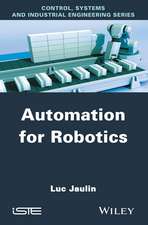Interleaving Planning and Execution for Autonomous Robots: The Springer International Series in Engineering and Computer Science, cartea 385
Autor Illah Reza Nourbakhshen Limba Engleză Hardback – 30 noi 1996
Interleaving Planning and Execution for Autonomous Robots is based on the author's PhD research, covering the same material taught in CS 224, the very popular Introduction to Robot Programming Laboratory taught at Stanford for four years by Professor Michael Genesereth and the author.
| Toate formatele și edițiile | Preț | Express |
|---|---|---|
| Paperback (1) | 639.20 lei 6-8 săpt. | |
| Springer Us – 12 oct 2012 | 639.20 lei 6-8 săpt. | |
| Hardback (1) | 645.31 lei 6-8 săpt. | |
| Springer Us – 30 noi 1996 | 645.31 lei 6-8 săpt. |
Din seria The Springer International Series in Engineering and Computer Science
- 24%
 Preț: 1041.97 lei
Preț: 1041.97 lei - 20%
 Preț: 643.50 lei
Preț: 643.50 lei - 18%
 Preț: 1225.62 lei
Preț: 1225.62 lei - 18%
 Preț: 965.02 lei
Preț: 965.02 lei - 20%
 Preț: 646.12 lei
Preț: 646.12 lei - 18%
 Preț: 948.79 lei
Preț: 948.79 lei - 20%
 Preț: 646.62 lei
Preț: 646.62 lei - 15%
 Preț: 637.46 lei
Preț: 637.46 lei - 20%
 Preț: 643.83 lei
Preț: 643.83 lei - 18%
 Preț: 949.23 lei
Preț: 949.23 lei - 20%
 Preț: 644.48 lei
Preț: 644.48 lei - 20%
 Preț: 994.92 lei
Preț: 994.92 lei - 20%
 Preț: 645.97 lei
Preț: 645.97 lei - 18%
 Preț: 946.87 lei
Preț: 946.87 lei - 20%
 Preț: 995.57 lei
Preț: 995.57 lei - 18%
 Preț: 956.99 lei
Preț: 956.99 lei - 20%
 Preț: 644.98 lei
Preț: 644.98 lei - 15%
 Preț: 649.54 lei
Preț: 649.54 lei - 18%
 Preț: 950.21 lei
Preț: 950.21 lei - 18%
 Preț: 1221.38 lei
Preț: 1221.38 lei - 18%
 Preț: 957.62 lei
Preț: 957.62 lei - 15%
 Preț: 643.99 lei
Preț: 643.99 lei - 18%
 Preț: 948.47 lei
Preț: 948.47 lei - 18%
 Preț: 947.35 lei
Preț: 947.35 lei - 20%
 Preț: 1284.65 lei
Preț: 1284.65 lei - 20%
 Preț: 1628.31 lei
Preț: 1628.31 lei - 20%
 Preț: 1285.78 lei
Preț: 1285.78 lei
Preț: 645.31 lei
Preț vechi: 806.64 lei
-20% Nou
Puncte Express: 968
Preț estimativ în valută:
123.48€ • 129.27$ • 102.17£
123.48€ • 129.27$ • 102.17£
Carte tipărită la comandă
Livrare economică 05-19 aprilie
Preluare comenzi: 021 569.72.76
Specificații
ISBN-13: 9780792398288
ISBN-10: 0792398289
Pagini: 145
Ilustrații: XVII, 145 p.
Dimensiuni: 155 x 235 x 11 mm
Greutate: 0.41 kg
Ediția:1997
Editura: Springer Us
Colecția Springer
Seria The Springer International Series in Engineering and Computer Science
Locul publicării:New York, NY, United States
ISBN-10: 0792398289
Pagini: 145
Ilustrații: XVII, 145 p.
Dimensiuni: 155 x 235 x 11 mm
Greutate: 0.41 kg
Ediția:1997
Editura: Springer Us
Colecția Springer
Seria The Springer International Series in Engineering and Computer Science
Locul publicării:New York, NY, United States
Public țintă
ResearchCuprins
1 Introduction.- 1.1 Motivation.- 1.2 Contributions.- 1.3 Contents of Chapters.- 2 Perception and Action.- 2.1 The Situated Robot and its Environment.- 2.2 Defining State and State Update.- 2.3 Comparison to other Conventional Approaches.- 2.4 Conclusion.- 3 Formalizing Incomplete Information.- 3.1 Sources of Incomplete Information.- 3.2 Representing Incomplete Information.- 3.3 State-Set Tracking: Execution Monitoring.- 3.4 Related Work.- 4 Goal-Directed Control Systems.- 4.1 Defining a Problem Instance.- 4.2 Advance Planning Control Systems.- 4.3 Related Work.- 5 Interleaving Planning and Execution.- 5.1 Introduction: Interleaving.- 5.2 Premature Search Termination.- 5.3 Experimental Results.- 5.4 Related Work.- 6 Using Assumptions to Oversimplify.- 6.1 Introduction.- 6.2 Assumptions.- 6.3 Assumptive Control Systems.- 6.4 Continuous Selection Algorithm.- 6.5 The Cost of Assumptions.- 6.6 Large-scale Real-World Experimental Results.- 6.7 Related Work.- 6.8 Conclusion.- 7 Strategic Subgoaling: Using Abstraction Systems.- 7.1 Introduction.- 7.2 Problem Spaces.- 7.3 Abstraction.- 7.4 Examples of Abstraction Systems and their Cost.- 7.5 Related Work and Discussion.- 8 Generalizing beyond State Sets>.- 8.1 Introduction.- 8.2 Representation Examples.- 8.3 Conclusion.- 9 Conclusions.










